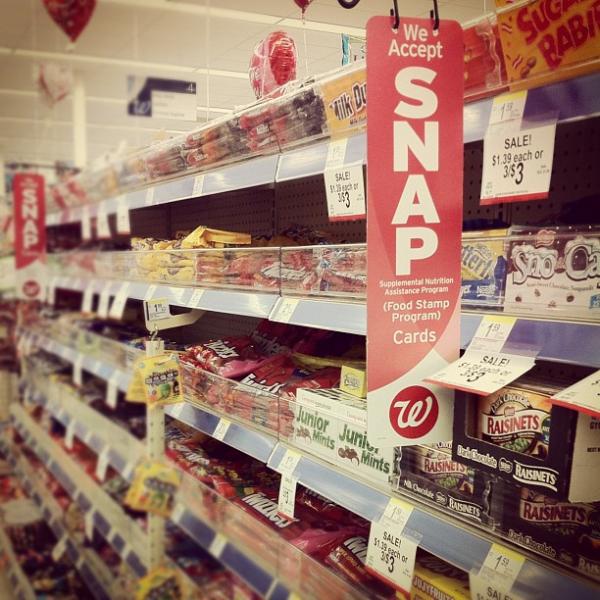Thinking About Food Stamps: SNAP Judgments About American Poverty

That’s an easy proclamation to make. But with all the accusations, insults and promises being lobbed back and forth between Governor Romney and President Obama, discovering the facts behind issues plaguing the campaign trail today can be tricky, especially for first-time voters like myself. One of the largest points of contention this election year is quite obvious: the state of the economy. Every politico, journalist and blogger has found some indication of why one side or the other should be leading the United States back to economic glory. But how far back do we have to go, as a nation, to reach that pinnacle of financial security and luxury?
There has been a lot of criticism lately against the Obama administration concerning his work, or lack thereof, to “fix” the economy. And many of these complaints are coupled with data intended to shock or inflame the critics’ audience. Within the last week, various media sources have been spouting the most recent figures released by the U.S. Department of Agriculture about SNAP usage. SNAP, or the Supplemental Nutrition Assistance Program, was the name adopted in 2008 for what we know as the “food stamp” program. According to the U.S. Dept. of Agriculture, in this past June, 46.7 million Americans used food stamps to feed themselves and their families, costing the nation around $76 billion.
Learning that 15 percent of Americans currently use government aid just to feed themselves should undoubtedly create genuine concern for our economy. But an unfortunate side effect of publicizing these types of facts and figures is the brash assumptions about what these numbers might mean. So, while fiscal conservatives are touting these numbers as the epitome of Obama’s ineptitude as president, there is a need to better explore the reasons that use of SNAP has increased by 51 percent since October of 2008. The appropriate response is not to lay all the blame on liberal initiatives since Obama’s inauguration, as Romney did when he oversimplified the situation to indicate that Obama simply “[added] 15 million people [to SNAP].”
When looking at all the circulating information on the food stamp situation, many of the figures seem to spark contradictory reactions. On one hand fiscal conservatives cite these figures as evidence Obama is trying to create a "welfare state," but on the other hand, while the number “46.7 million” is highly alarming, we also need to understand that the number of people on SNAP is now “roughly the same as the number of Americans living in poverty.” The entire purpose of food stamps has always been to ensure that those in poverty are able to eat. And clearly, looking at the official poverty thresholds in the U.S., even those individuals technically above the poverty line are likely still struggling to make ends meet. So, the question is: why has it taken until now for the number of food stamp users to rise to such heights?
The media has focused on the recession for a while now, emphasizing the fact that the difficult economic times were impacting everyone. Finding ways to save money became a fact of American society. Any means to do this, from cutting coupons to using the dreaded public transportation system, became acceptable. Almost overnight, blogs, forums, and cutely coined terms like “Recessionista” popped up everywhere; thrifty became the new black. Even the government caught on, attempting to erase the stigma of food stamps by dubbing the program SNAP in the 2008 farm bill. Additionally, finding out if you qualify became exceptionally easy. SNAP has a Pre-Screening Eligibility Tool online that promotes easy access to information about how much any family would be eligible to receive.

So, if those who were perhaps ineligible for the program prior to the recession experienced a drop in income or a rise in expenses by the requisite amount necessary to lower them to the level “official” poverty (as occurred across the country), it would make sense that higher numbers of eligible recipients, combined with social acceptability, would popularize food stamp use among those who need the assistance.
Although the reliance of about 1/6 Americans on food stamps is not ideal, the slowed growth in number of Americans using food stamps should not be ignored. During Obama’s term, the increase in food stamp use lowered from 23 percent to 3 percent growth. This shows that, despite the increases due to social acceptability and higher rates of eligibility, the use of food stamps is not a trend based solely on ease of access and misuse of SNAP. In fact, the average person on food stamps leaves the program after about nine months. And although Newt Gingrich has dubbed Obama the “best food stamp president” in U.S. history, if you look back to before the recession, you will find that during Bush’s administration, food stamp usage began its rise with the 2002 farm bill.
So, in effect, if you wish to cast responsibility of all economic changes in the last four years on Obama, as conservatives seem to nowadays, Obama is responsible for slowing down a trend that began six years before his presidency, not for aggravating one.
Reach Contributor Zion Samuel here.



